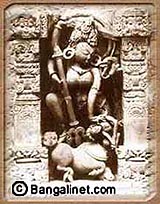 |
| a home away from home |
| HOME FEEDBACK TELL A FRIEND WEB SITE DESIGN CAREER WITH US CONTACT US |
 |
A fierce battle took place. Finally when Mahishasura in the guise of a buffalo charged against Durga, the Devi beheaded the buffalo and from it emerged Mahishasura in his original form. Durga pierced his chest with the trident and relieved the world from the evil power. That is why she is 'Durgatinashini Durga', our mother goddess who destroys the evil, protects her devotees and establishes peace and prosperity on earth.We worship Durga as the mother goddess, the epitome of 'Shakti' (divine power), to deliver us from the evil and bring peace and prosperity in our lives. But the |
|
most interesting part of Durga Puja is that, instead of placing Durga on a high alter and worshipping her from a distance the Bengalis embrace her in their hearts and make her an inseparable member of the family. Goddess Durga is welcomed to the earth as our daughter who annually visits her parents' home. Durga stays for four days-Sashti, Saptami, Ashtami and Nabami along with her children, Ganesha, Laxmi, Kartik and Saraswati and sets for her husband's abode on Vijaya Dashami. Durga's mode of journey to the earth is detailed in scriptures. The modes, an elephant, a horse, palanquin, boat all signify luck or omen which influence the life on earth. The elephant signifies prosperity and good harvest while journey on a horse back |
|
|
|
indicates
drought, a palanquin spells wide spread epidemic and the boat suggests
flood and misery. The worship of Devi Durga in the month of October
however owes its origin to Krittibas Ojha's "Ramayana".
|
GREAT INDIANS || BENGALI SECTION || BENGALI MARRIAGE || BABY'S NAME || WALLPAPER || BENGAL || WEATHER || TRAVEL
MOBILE WALLPAPER || E-CARD || MOVIE || WEBSITE LINKS || ASSOCIATIONS || SHOPPING || ASTROLOGY || MUSIC || BEAUTY CARE
TIGER || NEWS || GUEST CORNER || FEEDBACK || LINK TO US || FOR ADVERTISING || SERVICES || CONTACT || BENGALI CALENDAR
Graphics, Sound or content copied or produced in part or whole in any media will be illegal.
Persons or websites caught using our material will be penalized.
Privacy Statement || Copyright
Copyright ©1999-2016 BANGALINET.COM
